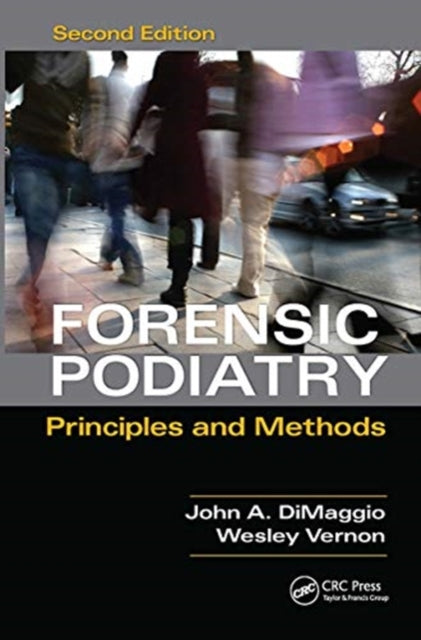Denis Wesley Vernon,John A. DiMaggio
Forensic Podiatry: Principles and Methods, Second Edition
Forensic Podiatry: Principles and Methods, Second Edition
YOU SAVE £3.60
- Condition: Brand new
- UK Delivery times: Usually arrives within 2 - 3 working days
- UK Shipping: Fee starts at £2.39. Subject to product weight & dimension
Bulk ordering. Want 15 or more copies? Get a personalised quote and bigger discounts. Learn more about bulk orders.
Couldn't load pickup availability
- More about Forensic Podiatry: Principles and Methods, Second Edition
Forensic Podiatry: Principles and Methods, Second Edition, has been updated to reflect the latest developments and advancements in the field, including new chapters on the expert witness, Frye Test, and Daubert Standard, revised theories on gait analysis, bare footprint identification, and footwear examination, and extensive case studies and an international compilation of current best practices.
Format: Paperback / softback
Length: 348 pages
Publication date: 31 March 2021
Publisher: Taylor & Francis Ltd
Forensic Podiatry: Principles and Methods, Second Edition, has undergone a comprehensive update to align with the latest developments and advancements in this dynamic field. This revised edition introduces numerous new chapters, encompassing the expert witness, Frye Test, and Daubert Standard, as well as revised theories on gait analysis, bare footprint identification, and footwear examination. Extensive case studies and a comprehensive international compilation of current best practices are included in this edition, providing valuable insights for students, practicing forensic podiatrists, legal professionals, and those seeking to enter the profession.
Since the initial publication of this text, the field of forensic podiatry has experienced a remarkable transformation, evolving from relative obscurity to a vibrant and internationally recognized discipline. Forensic podiatrists have played a pivotal role in driving advancements in the field, expanding the range of applications and enhancing the practice through innovative techniques to strengthen evidentiary conclusions.
Forensic Podiatry, authored by two pioneers in the field, offers a comprehensive and detailed exploration of the subject matter. With over one hundred meticulously illustrated chapters, this text serves as an invaluable resource for students, practicing forensic podiatrists, legal professionals, and individuals seeking to gain a deeper understanding of this field.
The book begins by providing an introduction to the principles and methods of forensic podiatry, encompassing the examination and analysis of footwear, footprints, and other physical evidence. It delves into the legal framework and ethical considerations associated with forensic podiatry, emphasizing the importance of maintaining objectivity and adhering to strict guidelines.
The second chapter focuses on gait analysis, a crucial aspect of forensic podiatry. The authors discuss various methods and techniques used to evaluate the walking pattern of individuals, including video analysis, motion capture systems, and biomechanical modeling. They explore the significance of gait analysis in identifying suspects, determining the cause and manner of injury, and reconstructing events.
Subsequent chapters cover bare footprint identification, a specialized field within forensic podiatry. The authors provide detailed instructions on how to examine and identify bare footprints, including the use of photography, casting techniques, and digital imaging. They discuss the factors that influence footprint identification, such as footwear, surface conditions, and human anatomy, and explore the challenges associated with this process.
Footwear examination is another critical area covered in the book. The authors discuss the various methods and techniques used to examine footwear, including visual inspection, microscopical analysis, and chemical testing. They explore the significance of footwear examination in criminal investigations, such as determining the type of footwear worn by the perpetrator, identifying potential evidence, and reconstructing events.
The book also includes chapters on footwear forensics, injury analysis, and legal aspects of forensic podiatry. The authors provide insights into the role of forensic podiatrists in legal proceedings, including testimony, expert opinions, and evidence presentation. They discuss the challenges faced by forensic podiatrists in court, such as cross-examination, and the importance of maintaining credibility and objectivity.
In conclusion, Forensic Podiatry: Principles and Methods, Second Edition, is a comprehensive and authoritative resource for students, practicing forensic podiatrists, legal professionals, and those interested in the field of forensic science. Written by two pioneers in the field, this text offers a wealth of knowledge and expertise, providing a solid foundation for understanding the principles and methods of forensic podiatry. With its extensive case studies, international compilation of current best practices, and detailed illustrations, this book is an invaluable tool for advancing the field and improving evidentiary conclusions.
Weight: 685g
Dimension: 234 x 156 (mm)
ISBN-13: 9780367778392
Edition number: 2 New edition
This item can be found in:
UK and International shipping information
UK and International shipping information
UK Delivery and returns information:
- Delivery within 2 - 3 days when ordering in the UK.
- Shipping fee for UK customers from £2.39. Fully tracked shipping service available.
- Returns policy: Return within 30 days of receipt for full refund.
International deliveries:
Shulph Ink now ships to Australia, Belgium, Canada, France, Germany, Ireland, Italy, India, Luxembourg Saudi Arabia, Singapore, Spain, Netherlands, New Zealand, United Arab Emirates, United States of America.
- Delivery times: within 5 - 10 days for international orders.
- Shipping fee: charges vary for overseas orders. Only tracked services are available for most international orders. Some countries have untracked shipping options.
- Customs charges: If ordering to addresses outside the United Kingdom, you may or may not incur additional customs and duties fees during local delivery.


